The History of Bruce Spruce Ranch
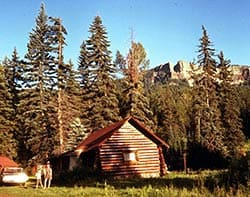
(Click images to view larger)
In the mid-1930s Judge Leslie Bruce and his wife Frankie from Pleasant Hill, Missouri bought the 360 acre McCoy homestead that had a lodge, a couple of cabins and a barn. From that, they created Bruce Spruce Ranch, a guest ranch in the beautiful San Juan Valley at the foot of Wolf Creek Pass. During the next several years more cabins were added.
In 1954, Chuck Faris and his wife Ruth from Oklahoma City bought the 40 acres containing the cabin complex from Judge Bruce and Frankie. They continued renting the cabins and making them more modern for the times.
In 1966, Craig Hinger, his dad Oscar Hinger, and another business partner bought the ranch and took over its operation. During these years they added more cabins and made some overall improvements in the camp. One of the improvements was the addition of camping RV spaces.
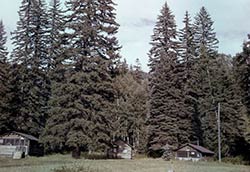
In 1967, Craig Hinger married Eugenia Reynolds and his bachelor partner also married. They continued operating Bruce Spruce Ranch until the partner sold out in 1969. When Oscar Hinger died in 1972, Craig and Eugenia became sole owners until 2000, when they decided to step back a bit and took their sons Chris and Rusty into partnership.
Today, the four Hingers, with the help of other family members, continue operating the guest ranch and making improvements, welcoming some families every year into the fourth generation. It is a great place to bring family to relax, fish, hike, sight-see or go horseback riding.
Back in the Day
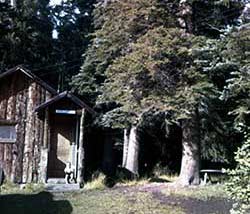
During the Judge Bruce era (1930s) there were no commodes, only outhouses; no running water, only hand pumps; no electricity except in the evenings for about two hours (generator), then kerosene lamps; and no telephones at first, then an eight-party line service.
There were no refrigerators, but one could buy ice from the Bruce’s which they kept in a sawdust box by the lodge. Fishing was a much bigger pastime and the limit was more than 20 trout.
The bedding was not provided for the cabins but you could rent pillowcases for 5 cents and sheets were 10 cents. They say if you knocked on the door of the lodge during nap time, you were not received well at all.
The cabins rented for somewhere in the area of $2.00 per night, and reservations were made at least a year in advance.
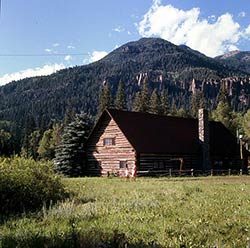
It’s also interesting to note that all cooking and heating in the cabins was done with wood cook stoves and not until the late 1960s or early 1970s did we change to propane cook stoves and pot-bellied heat stoves.
Something else of note during the Judge Bruce era is that, although there was no running water in any of the cabins, there was running water in the Lodge and the laundry room. As a result of that, there was a single shower room for women and a single shower room for men located on the back side of the laundry.
Now, waiting in line is not normally something one looks forward to, but waiting in line was something guests at that time got used to. In fact, it was a most pleasant time of visiting about the day’s fishing, politics or just about anything else. There is a picture of guests dressed in bathrobes leaning against the old rail fence in front of the lodge waiting their turn.
Incidentally, all of the hot water was produced from a wood or coal fired hot water heater which required someone to build the fire or cold showers were sure to follow.
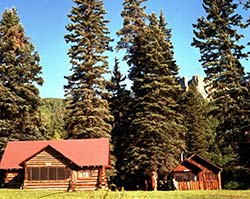
Cabins No Longer at Bruce Spruce Ranch
Bo Peep
It might be noted that at one time just before the demolition of the Bark Inn and the construction of the Chipmunk, there was a very small and very rustic one bed cabin called the Bo Peep. It was never used by the Hingers, but was used by the Bruces at one time.
It was torn down and removed at the same time the Bark Inn was demolished. All the walls in the Bo Peep were papered with newspapers. Talk about interesting reading from yesteryear. Also found during the demolition were very old stamps, coins, and gas ration tokens from the World War II era.
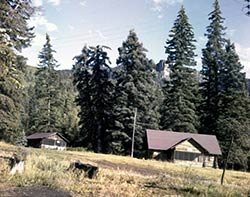
Trailer Inn
The Trailer Inn, even when Craig was a child, was composed of a very old “RV” with a porch added on to the front door area which served as the kitchen area. The only people I ever knew to use this cabin, and only when I was a child, were the wranglers running the horses for Judge Bruce.
The Trailer Inn was abandoned in the early 1950s and torn down after the Hingers bought the Ranch in 1966. This cabin was also a creation of the Judge Bruce era. The Trailer Inn sat in the area where RV Sites 30 and 31 now exist.
Balsam
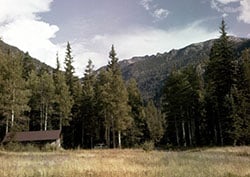
The Balsam was named after the balsam spruce found locally. This slab constructed cabin sat in the area where RV Site 25 and 26 now exist. It was built in the mid 1930s by the Judge Bruce carpenters and was in use for over 20 years.
The only time I have ever seen it in use was in 1966 when two old Indian prospectors came by the Ranch and needed a place to stay. We cleaned all the hay and junk out of the Balsam and they said it was a grand home. They stayed with us for two or three weeks prospecting and the stories we could tell about those two are quite interesting. The Balsam was torn down in 1967.
